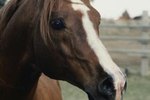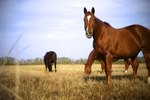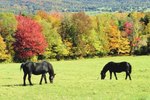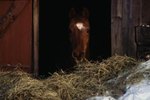
Lush, young spring grass is tempting to your horse after a long winter of hay and grain, but eating too much of it can bring on serious abdominal pain known as colic. As with the founder that also can follow too much spring grass consumption, moderation is the key to prevention of grass colic. Controlling your horse's exposure to new spring grass can eliminate much of the health concern associated with this food source.
Definition
Grass colic is a type of spasmodic colic caused by gas buildup in the intestinal tract. It can occur when a horse ingests too much grass to which he is unaccustomed. A horse is at risk of colic whenever his diet suddenly changes, whether the change is to grass, grain or another unaccustomed feed. It is important to make changes in your horse's diet gradually, over a period of days and weeks.
Symptoms
A horse who is suffering from grass colic will show he's in pain by kicking at his stomach, lying down and getting up in an attempt to get comfortable, turning to look at his stomach, and generally appearing restless. He may also paw at the ground or roll and thrash wildly, and the pain will cause him to perspire. If you get close to his side you may notice his stomach making an excessive amount of noise, or no noise at all.
Treatment
Always treat colic as a medical emergency. Call the veterinarian immediately if you see symptoms. Keep your horse up and walking while you wait for the vet to arrive, so that he doesn't roll and thrash, possibly worsening the problem. Often, the motion of walking will be enough to ease the pressure in the digestive tract, and help your horse feel better. Your vet will check your horse's vital signs, insert a tube to the stomach to relieve pressure and check for obstructions, and perform a rectal exam, also to check for obstructions. He may administer a pain reliever.
If your horse is in severe pain, or your vet suspects a complication such as intestines that have become twisted (torsion), telescoped (intussusception) or impacted, it may be necessary to transport your horse to a veterinary hospital for emergency surgery. If such complications are ruled out, then pain relief, hydration and light exercise may be sufficient to make your horse feel better.
Prevention
Grass colic often occurs in early spring, because new spring grass is abundant and washy, and it contains high levels of fructans, a type of sugar that is difficult for horses to digest. The sudden influx of large quantities of fructans into the horse's digestive tract can cause gases to form in the intestines, distending them and creating pressure and pain.
To minimize the chances of grass colic, it is important to allow your horse to get accustomed to the new growth gradually. You can do that by limiting turnout time, gradually increasing the time your horse grazes each day. Discuss methods of getting your horse accustomed to spring grass with your veterinarian to find an optimum plan for your particular situation.
Pasture Management
You can manage your spring pasture to make it a little more friendly to your horse. Cool-season grasses, which are common in horse pastures, have naturally higher levels of fructans. If your pasture is made up of mostly cool-season grasses such as orchard grass, timothy, ryegrass and brome, expect high levels of fructans in the spring. Fructan levels are higher in the afternoon and evening, so consider turning your horse out to graze in the mornings. The exception to this is periods of time when the days are warm and sunny and the nights are cold. During such times, early morning grasses are likely to be high in fructans.
Finally, don't overgraze the pasture. The fructans are more concentrated near the roots of the grass, so overgrazed pastures will naturally have a higher sugar content.
References
Photo Credits
-
Comstock/Comstock/Getty Images




